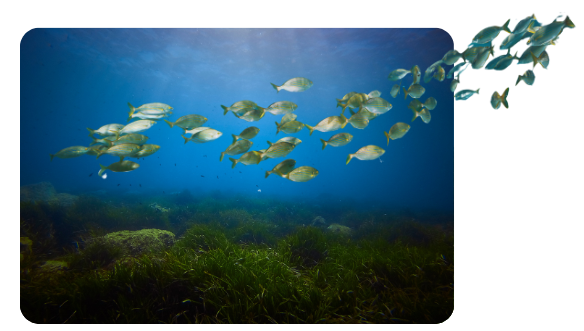Story
Learning to better understand the language of algae
09 December 2022
International research duo highlight the ecological significance of chemical communication by algae.

More than any other time in history, today, communication is everything and surprisingly, this applies to algae too. The language of these aquatic plants was first detected in investigations of macroalgae in the early 1970s, however, their communication and its significance in aquatic ecosystems still remains largely unknown.
A research duo from the Helmholtz Centre for Environmental Research (UFZ) and Plymouth Marine Laboratory (PML) have published in Biological Reviews a summary of the current state of knowledge about algal communication, and identifies new approaches for future research in algal language and their ecological interactions.
Dr. Mahasweta Saha, marine chemical ecologist at PML and lead author of this paper, said: “We hope this paper will help consolidate current knowledge of this often overlooked area as well as highlight knowledge gaps so that we, as a society, can begin to understand these fascinating but complex interactions to better protect them for the future as well as identify opportunities for novel application”.
So, can algae actually talk? “Well, although they don’t have any mouth or ears, algae still communicate with their own kind and with other organisms in their surroundings,” says Dr Patrick Fink, a fresh and marine water ecologist at UFZ.
Algae sometimes do this with volatile organic substances that they release into the water and these chemical signals, known as BVOCs (biogenic volatile organic compounds), are the equivalent of odours in the air with which flowering plants communicate and attract their pollinators. When under attack by parasites, some plant species even release odours that attract the parasites’ natural enemies to them.
“Algae also employ such interactions and protective mechanisms,” says Dr Fink. “After all, they are among the oldest organisms on Earth and chemical communication is the most original form of information exchange in evolutionary history. However, our knowledge in this area still remains very fragmented.”
Dr Fink continued: “We know from laboratory investigations that some species of cyanobacteria keep water fleas at bay by releasing BVOCs in the water. This signal apparently acts as a repellent and creates an effective grazing protection”.
In contrast, it is not yet understood why some freshwater algae, growing as biofilms on rocks or shellfish shells for example, release BVOCs on grazing pond snails as these chemical signals inexplicably attract more snails. “The pond snails very clearly use the BVOCs to their advantage but it remains unknown what function the chemical release serves for the algae,” says Dr Fink.
In the ocean, a diatom bloom represents a true feast for copepods. This rich offering of nutrients should ensure that the copepod population subsequently grows, however, this is not the case and impacts on their young are being observed.
“Although the copepods are well nourished, the spawn that they carry with them in their egg sack is at serious risk. This is because the BVOCS from the diatoms impede cell division and thus disrupt embryonic development,” Fink explains “In this way, the diatoms prevent excessive predation on their descendants and thereby ensuring the preservation of their kind.”
As for the algae’s language of love, “Macroalgae, such as the bladder wrack seen right along the UK coastline, reproduce by releasing gametes into the water. The male and female gametes each release pheromones so that they can find each other in the vastness of the ocean,” explains Dr. Saha. “In the early days of research in this area, this was the first indication that algae communicate via chemical signals, and that they fulfil important ecological functions.”
In their publication, the author duo reference the presumed significant effect of BVOCS within aquatic ecosystems, identifies gaps in knowledge and indicates possible future research areas. These include co-evolutionary processes between signal senders and receivers and the consequences of environmental changes on aquatic ecosystems, caused by humans.
“As primary producers, algae form the basis of life of all aquatic food webs,” says Fink. “It is therefore important that we learn to better understand the chemical communication of algae and their basic functional relationships in aquatic ecosystems.”
The authors believe that increased understanding of the language of algae could also have useful technical applications, such as in using chemical signals to deter parasites, thereby reducing the use of pharmaceuticals in aquaculture.
Dr Saha continued: “These chemical signals could even help us develop highly-effective and environmentally friendly biocide treatments, such as anti-biofouling paint used on boat hulls and other marine infrastructure”.
A better understanding of the chemical communication paths is also important to enable the development of more efficient environmental stewardship strategies, especially in response to climate change and ocean acidification. Initial studies show that the chemical communication process of marine algae is disrupted by increasing ocean acidification.
“We can’t protect waters unless we understand the functioning of their internal regulation mechanisms”, says Fink. “It is also highly likely that there will be interactions between micropollutants of human origin and the algal BVOCs. This disrupts the finely balanced chemical communication processes that have remained stable over extended periods, which can have serious consequences for the future function of the aquatic ecosystem”.
Related information
Mahasweta Saha, Patrick Fink (2022). Algal volatiles – the overlooked chemical language of aquatic primary producers. Biological Reviews, 01 August 2022. https://doi.org/10.1111/brv.12887
Original article by Helmholtz Centre for Environmental Research
